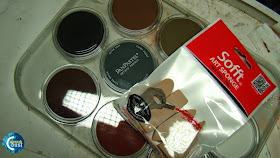
The second part of the history about creation of the scenic base for model "Normandy 1944" by Nocturna Models. In the previous part I finished applying the base colors. This time we will focus on painting exposed elements of the wall, bricks and rubble. Also begin the weathering. We will continue to work on contrast.
Druga część historii tworzenia podstawki scenicznej do modelu "Normandy, 1944" firmy Nocturna Models. W poprzednią części zakończyłem nakładanie bazowych kolorów. Tym razem skupimy się na pomalowaniu odsłoniętych w murze cegieł i gruzu. Rozpoczniemy również postarzanie (weathering). Nadal będziemy pracować nad zwiększeniem kontrastu.
Druga część historii tworzenia podstawki scenicznej do modelu "Normandy, 1944" firmy Nocturna Models. W poprzednią części zakończyłem nakładanie bazowych kolorów. Tym razem skupimy się na pomalowaniu odsłoniętych w murze cegieł i gruzu. Rozpoczniemy również postarzanie (weathering). Nadal będziemy pracować nad zwiększeniem kontrastu.
For starters, if you have not read, please look at the first part of this article:
Na początek, jeśli jeszcze nie czytaliście, proszę zapoznajcie się z pierwszą częścią tego artykułu:
We will begin by painting bricks. For this purpose, I used several shades of red and orange. I have diluated paint and painted them so that the colors blended with each other.
Rozpoczniemy od malowania cegieł. Do tego celu użyłem kilka odcieni koloru czerwonego oraz pomarańczowy. Farby rozwodniłem i malowałem nimi tak, by kolory się wzajemnie mieszały.
I painted the brick lying in the rubble.
Pomalowałem również cegły leżące w gruzie.
Several items of debris were painted in the colors of the plaster on the wall.
Kilka elementów gruzu pomalowałem w kolorach tynku na ścianie.
Using several colors of Vallejo Model Wash, added shades to rubble and bricks.
Używając kilka kolorów Vallejo Model Wash, dodałem odcieni na gruzie oraz cegłach.
It's time for some highlights. For this purpose, I used pastels for artists - PanPastel.
Przyszedł czas na rozjaśnienia. W tym celu użyłem pasteli dla artystów - PanPastel.
Pastels we put using special sponges. Rubbing them on dry surfaces.
Pastele te nakładamy specjalnymi gąbkami. Wcierając je na sucho w powierzchnie.
The brightest pastels color used, was white.
Najjaśniejszym użytym kolorem pasteli był kolor biały.
I used the brown pastels to weathering elements of the wall.
Użyłem również brązowych pasteli do przybrudzenia elementów muru.
Now it's time for the inks.
Teraz czas na tusze (ink).
I have used them to trace the edges of the individual elements, like previously described technique -Blacklining.
Użyłem ich by obrysować krawędzie poszczególnych elementów podobnie jak opisywana wcześniej technika - Blacklining.
Użyłem ich by obrysować krawędzie poszczególnych elementów podobnie jak opisywana wcześniej technika - Blacklining.
Now, I used white paint to brighten all possible edges.
Teraz użyłem białą farbę, by rozjaśnić wszystkie możliwe krawędzie.
It is enough in this, seconf part. Time for a little rest. In the next and final part of this article, we will the finish (weathering) to put live the entire mini-diorama. We will add pigments and paint the pedestal. We will also prepare label.
Tyle w tej części. Czas na mały odpoczynek. W następnej, ostatniej części tego artykułu, zakończymy postarzanie (weathering) aby ożywić całą mini dioramę. Dodamy pigmenty i pomalujemy piedestał. Wykonamy również plakietkę.
Go to part 3:
Have fun painting,
ARBAL

























